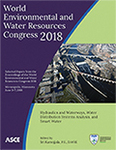World Environmental and Water Resources Congress 2018
Prediction of Location of Abutment and Contraction Scour Hole for Compound Channels
Publication: World Environmental and Water Resources Congress 2018: Hydraulics and Waterways, Water Distribution Systems Analysis, and Smart Water
ABSTRACT
Bridge scouring is a complex phenomenon, responsible for bridge damage and failure in many cases. Numerous studies have given empirical models for the bridge scour components, whereas, some investigators have studied the interactive bridge scour relationship. However; the location of the bridge scour has not been given due attention which affects the bridge stability and design and also governs the design of downstream structures. A detailed investigation has been conducted to study the location of point of deepest scour in the floodplain in a compound channel, which includes free, submerged orifice flow, and overtopping flow conditions. Experiments were conducted for five different abutment ratios in clear water scour condition for erodible spill-through abutments. Location of the point of deepest scour, both in flow and transverse direction were observed and model has been suggested to predict the location of point of deepest scour. This will help improve the bridge safety and economy along with the effect of scour on river training works in the vicinity of bridge.
Get full access to this chapter
View all available purchase options and get full access to this chapter.
REFERENCES
Arneson, L. A., Zevenbergen, L. W., Lagasse, P. F., and Clopper, P. E. (2012). "Evaluating scour at bridges." Hydraulic Engineering Circular 18 (HEC-18), U.S. Federal Highway Administration, Washington, D.C.
Froehlich, D. C. (1989). "Local scour at bridge abutments." Proc., National conference of Hydraulic Engineering, ASCE, New Orleans, LA, 13–18.
Gill, M. A. (1981). "Bed erosion in rectangular long contraction." J, Hydraulics Div., ASCE, 107(HY3), 273–294.
Gotvald, A. J., & McCallum, B. E. (2010). Epic flooding in Georgia, 2009 (No. 2010-3107). US Geological Survey.
Guo, J., Kerenyi, K., Pagan-Ortiz, J. E., and Flora, K. (2009). "Bridge pressure flow scour at clear water threshold condition." Trans. Tianjin Univ., 15(2), 79–94.
Hong, S. (2013). “Prediction of clear-water abutment scour depth in compound channel for extreme hydrologic events.” PhD. thesis, Georgia Institute of Technology.
Hong, Seung Ho, Sturm, T. W., and Stoesser, T. (2015). “Clear-water abutment scour depth in compound channel for extreme hydrologic events,” J. Hydraul. Eng., ASCE, 141(6).
Landers, M. N. (1992). "Bridge scour data management." Proc. ASCE Water Forum ’92. Baltimore, Maryland, 1094–1099.
Laursen, E. M. (1960). "Scour at bridge crossings." J. Hydraulics Div., ASCE, 86(2), 39–54.
Laursen, E. M. (1963). "An analysis of relief bridge scour." J. Hydraulics Div., ASCE, 89(3), 93–118.
Lyn, D. (2008). "Pressure-flow scour: A Reexamination of the HEC-18 equation." J. Hydraul. Eng., 134(7), 1015–1020. 244
Lyn, D. (2008a). "Turbulence models in sediment transport engineering," Chapter 16 in Sedimentation engineering: measurements, modeling, and practice, edited by M. Garcia, ASCE Manual of Practice No. 110, ASCE, Reston, VA.
Oben-Nyarko, K. and Ettema, R. (2011). “Pier and abutment scour interaction.” J. Hydraul. Eng., 137(12), 1598–1605.
Shan, H., Xie, A., Bojanowski, C., Suaznabar, O., Lottes, S., Shen, J., and Kerenyi, K. (2012). “Submerged flow bridge scour under clear water conditions.” Report FHWA-HRT-12-034, Federal Highway Administration, McClean, VA.
Shirole, A. M. and Holt, R. C. (1991). "Planning for a comprehensive bridge safety assurance program." Transportation Research Record 1290.
Straub, L. G. (1934). "Effect of channel contraction works upon regimen of moveable bed streams." Trans. American Geophysical Union part II.
Sturm, T. W. (2006). "Scour around bankline and setback abutments in compound channels." J. Hydraul. Eng., 132(1), 21–32.
Sturm, T. W. and Janjua, N. S. (1994). "Clear water scour around abutments in floodplains." J. Hydraul. Eng., 120(8), 956–972.
Sturm, T. W., Ettema, R., and Melville, B. (2011). "Evaluation of bridge-scour research: abutment and contraction scour progresses and prediction. Final Report, NCHRP Project 24–27(02)." Transportation Research Board, The National Academies, Washington, DC.
Umbrell, E. R., Young, G. K. Stein, S. M., and Jones J. S. (1998). "Clear-water contraction scour under bridges in pressure flow." J. Hydraul. Eng., 124(2), 236–240.
Information & Authors
Information
Published In
World Environmental and Water Resources Congress 2018: Hydraulics and Waterways, Water Distribution Systems Analysis, and Smart Water
Pages: 152 - 159
Editor: Sri Kamojjala, Las Vegas Valley Water District
ISBN (Online): 978-0-7844-8142-4
Copyright
© 2018 American Society of Civil Engineers.
History
Published online: May 31, 2018
Authors
Metrics & Citations
Metrics
Citations
Download citation
If you have the appropriate software installed, you can download article citation data to the citation manager of your choice. Simply select your manager software from the list below and click Download.
